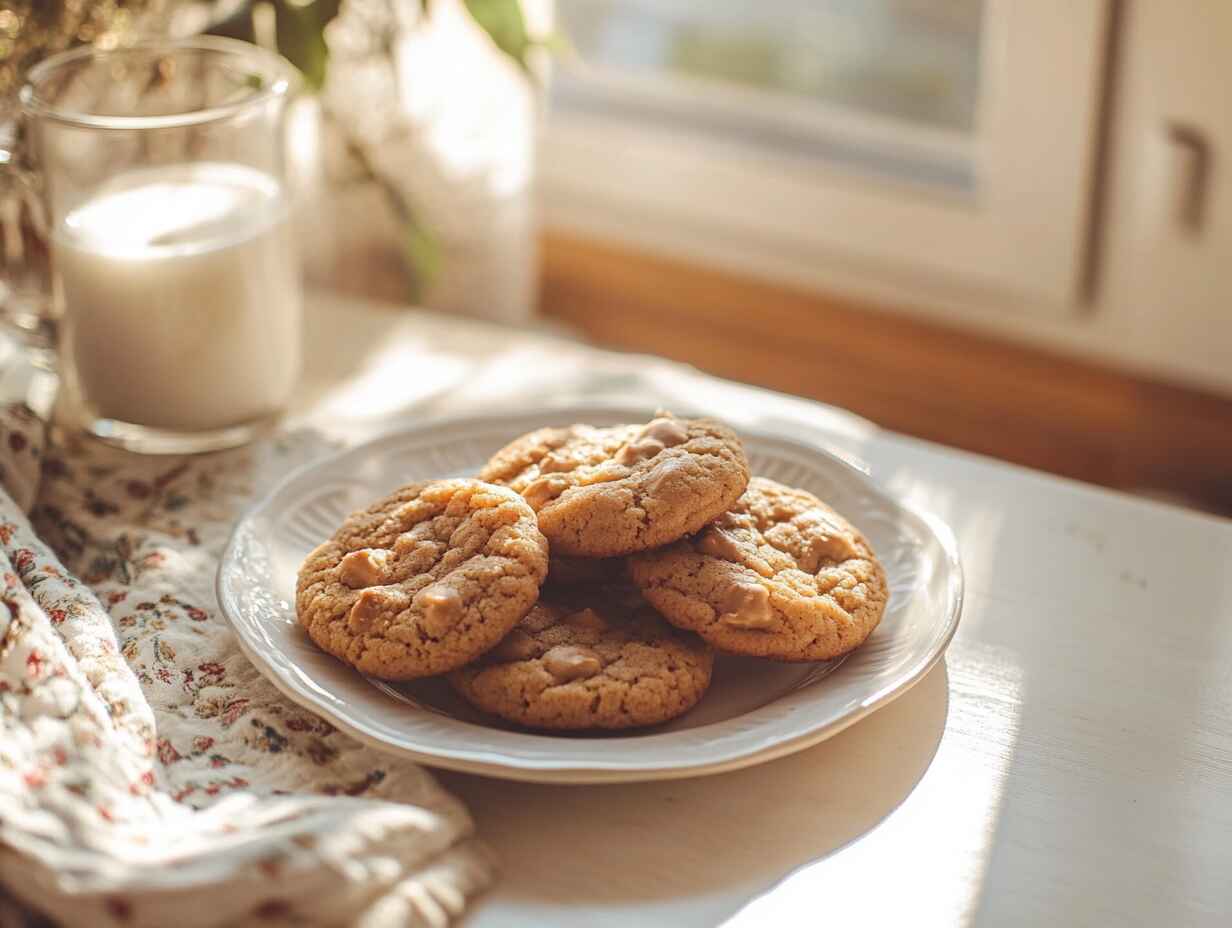Why aren’t my peanut butter cookies chewy? This is a common question among bakers who want that perfect combination of crispy edges, soft and chewy centers, and that delicious nutty flavor. Peanut butter cookies are a classic treat that most people love, but it can be frustrating when your batch doesn’t turn out as expected. Instead of that melt-in-your-mouth texture, you might find yourself with cookies that are too hard or crumbly. Let’s dive into the common reasons why this happens and how you can fix them to achieve the soft, chewy cookies you’ve been dreaming of!
Table of Contents
The Quest for Perfectly Chewy Peanut Butter Cookies
Why aren’t my peanut butter cookies chewy? If you’ve ever tried baking peanut butter cookies, you know they can be one of the most rewarding treats to make. But for many bakers, whether beginners or seasoned pros, achieving that soft, chewy texture can be a real challenge.
The frustration of baking a batch of cookies only for them to come out too hard or too crunchy is real!The good news? You don’t have to give up on your chewy cookie dreams. With the right tips and tricks, you can get that soft, chewy center every time you bake. So, let’s take a deep dive into why your cookies may not be turning out the way you want and what you can do about it!
Common Reasons Your Peanut Butter Cookies Aren’t Chewy
There are a number of reasons your peanut butter cookies may not be turning out chewy. Most of these issues are easy to fix, and understanding them will help you achieve the perfect texture. Below, we’ll explore the most common problems and how to solve them, so you can bake cookies that are always a hit.
Overbaking or Baking at Too High a Temperature
One of the most common reasons peanut butter cookies don’t turn out chewy is that they’ve been overbaked. Overbaking is a sneaky culprit, as it can happen quickly. When cookies are left in the oven too long, the moisture evaporates, leading to dry, crunchy cookies instead of soft, chewy ones. But how do you know when your cookies are done?
Here’s a tip: Peanut butter cookies continue to cook even after you remove them from the oven. So, it’s important to keep an eye on them. Typically, peanut butter cookies should bake for about 8-10 minutes at 350°F (175°C). The edges should look slightly golden brown, but the center should still appear a little soft. If you wait until the center is completely set, it’s too late your cookies will be hard. Learn more about why do my peanut butter cookies get hard and how to avoid it.
Incorrect Proportions of Ingredients
Another reason your peanut butter cookies may not be chewy has to do with the proportions of ingredients used in the recipe. Ingredients like flour, sugar, and butter each play a significant role in creating the right texture. If you don’t use the right amounts, the cookies might turn out too dry or dense.
Solution: Measure your ingredients carefully. Consider using a kitchen scale to weigh your flour, which can help you avoid adding too much. When it comes to fats, remember that peanut butter itself is a form of fat, so you want to make sure you’re adding enough of it. If you feel like your dough is too dry, try adding a tablespoon of milk or an extra egg for moisture. Consider exploring 4-ingredient peanut butter cookies for a simplified, foolproof recipe.
Using the Wrong Type of Peanut Butter
Not all peanut butter is created equal! While creamy peanut butter is typically the go-to choice for peanut butter cookies, using the wrong type can mess with the texture. Peanut butter that’s too oily or too dry can lead to cookies that are either too greasy or not chewy enough.
Solution: Opt for regular creamy peanut butter that is smooth and has a consistent texture. Avoid the “natural” kinds unless you’re prepared to make adjustments to your recipe. Stick to peanut butter that’s designed for baking to get that perfect chewy texture. Not all peanut butter is created equal! Discover why they put fork marks in peanut butter cookies for texture-related tips.
Not Enough Fat or Moisture in the Dough
Fat is crucial for giving cookies that chewy, soft texture. If you’re using too little fat, your cookies will come out dry and crumbly. On the other hand, too much fat can make your cookies greasy, which isn’t desirable either. The key is finding the right balance.
Solution: Ensure your recipe calls for the right amount of fat and liquid ingredients, like butter or oil. If you’re finding that the dough is too dry, add a tablespoon of milk or an extra egg. If it’s too greasy, reduce the amount of butter or oil.
Using All-Purpose Flour Instead of Cake Flour
The type of flour you use in your peanut butter cookies can have a big impact on the texture. While all-purpose flour is fine for many baked goods, it tends to create a denser, more crumbly texture in cookies. If you want a chewier cookie, cake flour can help achieve that lighter, softer texture you’re looking for.
Solution: Try substituting cake flour for all-purpose flour in your recipe. If you don’t have cake flour on hand, you can use all-purpose flour, but make sure to add a little more fat to help maintain moisture.
Key Ingredients That Affect Cookie Texture
When it comes to baking the perfect peanut butter cookies, every ingredient plays an important role. If you want chewy cookies, understanding the role of key ingredients like butter, eggs, flour, and sugar can make all the difference. In this section, we’ll break down how each of these ingredients contributes to the texture of your cookies and what you can do to adjust them for better results.
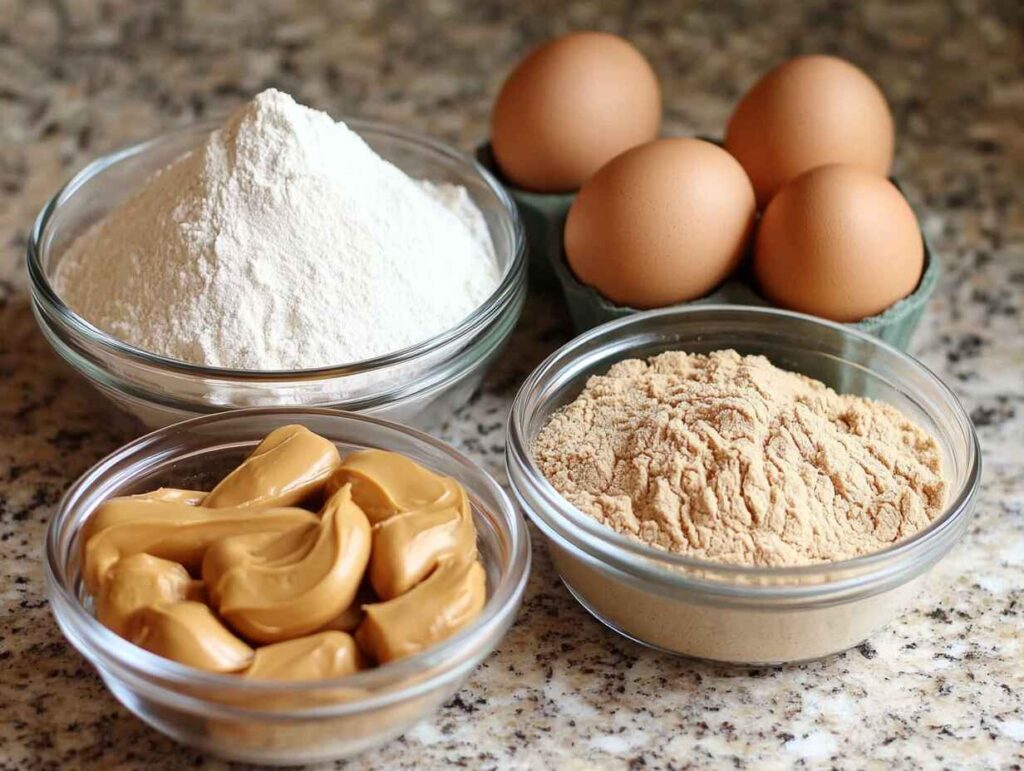
The Role of Butter and Oil in Peanut Butter Cookies
Butter is the secret to making your peanut butter cookies chewy. Why? Because it provides moisture, richness, and tenderness. The fat in butter softens the dough and prevents cookies from becoming too hard or crumbly. However, using the wrong kind of butter or not enough of it can lead to dry cookies.
Solution: If your peanut butter cookies are too dry, try using a mixture of butter and oil. If you’re using just butter, make sure it’s softened to room temperature so it blends smoothly with the other ingredients. Consider using a combination of butter and a neutral oil (like vegetable oil) for the best texture.
How Eggs Impact the Texture of Your Cookies
Eggs are another crucial ingredient when it comes to achieving the chewy texture in your cookies. Eggs provide structure, moisture, and richness. They act as a binding agent, holding the dough together and contributing to a soft, chewy texture. But using too many eggs or not enough can affect the final result.
Solution: Stick to the number of eggs called for in your recipe. If you find your cookies are too crumbly or dry, try adding an extra egg yolk for extra moisture. This will give the cookies a richer, chewier texture.
Flour: Why the Type of Flour Matters
Flour is one of the most important ingredients when it comes to cookie texture. The type of flour you use will determine how dense or light your cookies turn out. Most peanut butter cookie recipes call for all-purpose flour, but did you know that the type of flour can change the texture significantly?
Solution: Swap out some or all of the all-purpose flour for cake flour to get a lighter, chewier texture. If you don’t have cake flour, try using all-purpose flour but reduce the amount slightly, and make sure you add a little extra fat or moisture to compensate.
Sugar: Granulated vs. Brown Sugar
Sugar plays a huge role in the texture of your cookies. Granulated sugar creates a crispier texture, while brown sugar, which contains molasses, adds moisture and makes cookies chewier. So, if you want chewy peanut butter cookies, you should opt for brown sugar over granulated sugar.
Solution: Use more brown sugar than granulated sugar in your recipe for chewier cookies. If you’re feeling adventurous, try a 50/50 mix of brown and granulated sugar. This will give you a balance of chewy texture and a nice, golden-brown color.
Learn about the secret ingredient to keep cookies soft.
How to Fix and Prevent Common Peanut Butter Cookie Problems
By now, you have a better understanding of the key ingredients that affect cookie texture. But what if your peanut butter cookies still aren’t chewy, despite using the right ingredients? Don’t worry! In this section, we’ll discuss some simple fixes for common peanut butter cookie problems and how you can prevent them in future batches.
Adjusting Baking Time and Temperature for Perfect Chewiness
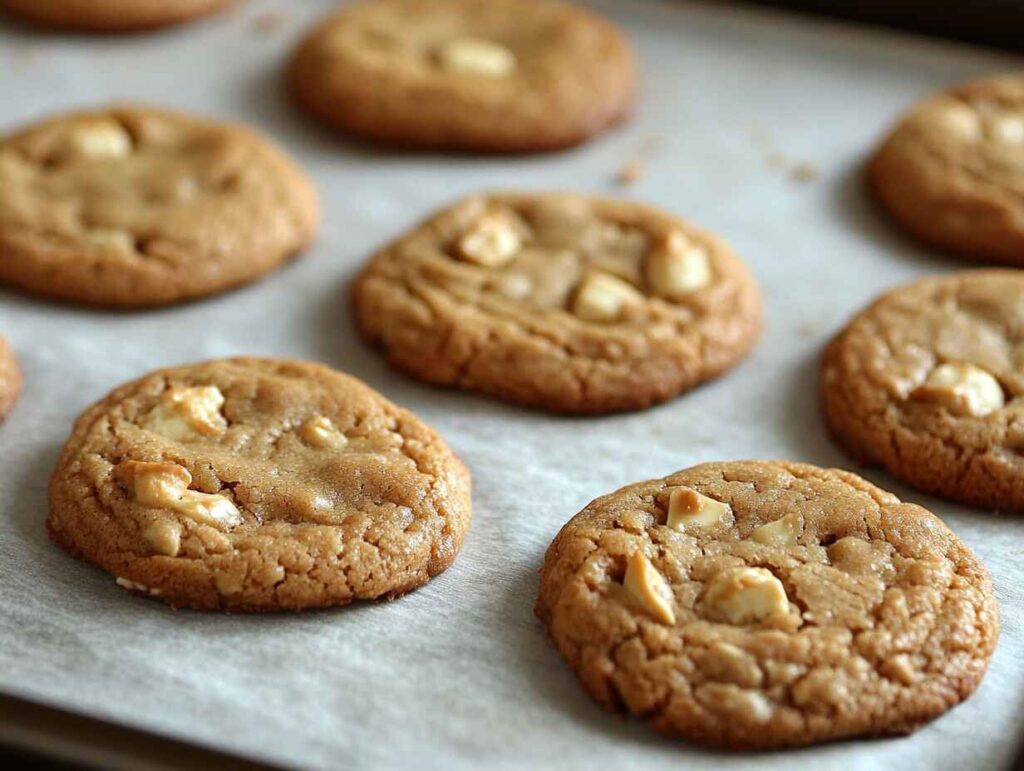
As we mentioned earlier, baking time and temperature play a major role in achieving chewy cookies. If your cookies are turning out too hard or crisp, the solution might be as simple as adjusting your oven settings.
Solution: Make sure your oven is preheated to the correct temperature, usually around 350°F (175°C). Keep a close eye on your cookies while they bake and check for doneness. Remember, peanut butter cookies continue to cook even after you remove them from the oven, so take them out when they still look slightly soft in the center. Let them rest on the baking sheet for a few minutes before transferring them to a cooling rack.
Measuring Ingredients Accurately
One of the biggest mistakes home bakers make is not measuring ingredients accurately. Too much flour, too little fat, or not enough sugar can all result in cookies that are not chewy. Accurate measurements are essential to getting the perfect texture.
Solution: Always measure your ingredients with precision. Use a kitchen scale for the most accurate measurements, especially for flour. If you don’t have a scale, use the spoon-and-level method for dry ingredients like flour scoop the flour into your measuring cup with a spoon and level it off with a knife for a more accurate measurement.
Choosing the Right Peanut Butter for Your Cookies
As we discussed earlier, the type of peanut butter you use can affect the texture of your cookies. You want to avoid using natural peanut butter, as it tends to be too oily and runny for cookies. Instead, go for creamy peanut butter that’s thick and smooth. The consistency of your peanut butter will help maintain the dough’s moisture and ensure your cookies turn out chewy.
Solution: Stick with regular, creamy peanut butter. If you’re using a brand with added sugar and oils, that’s okay just make sure it’s not the natural kind, which lacks the necessary consistency for baking.
Adding Extra Fat and Moisture to Your Dough
Another reason cookies might turn out dry and not chewy is because the dough lacks enough moisture. Peanut butter is a great source of fat, but sometimes it’s not quite enough to keep the dough soft and chewy. Adding a bit more fat or liquid can help.
Solution: Try adding an extra tablespoon of butter or a little bit of milk to the dough if it seems dry. A splash of vanilla extract can also help with moisture and flavor.
The Science Behind Chewy Peanut Butter Cookies
Understanding the science behind how cookies bake can help you troubleshoot problems and achieve the chewy texture you’re after. Baking is as much about chemistry as it is about creativity, and knowing how ingredients interact can lead to consistently perfect results. So, let’s break down the science behind chewy peanut butter cookies and how you can use it to your advantage!
How Gluten Forms and Affects Texture
Gluten is a protein found in wheat flour, and it plays a big role in how your cookies turn out. When flour is mixed with liquid (like eggs or butter), the proteins in the flour combine to form gluten. Gluten gives structure and elasticity to the dough, and too much of it can make cookies tough and chewy in the wrong way think of a hard, dense cookie that’s difficult to bite into. But too little gluten can cause cookies to fall apart or be too fragile.
Solution: Mix your dough just until combined. Overmixing can develop too much gluten, while undermixing can result in crumbly cookies. Aim for a dough that’s soft and pliable but not sticky.
The Role of Sugar Crystals in Chewy Cookies
Sugar isn’t just for sweetness its crystals play a major role in the texture of your cookies. When sugar is mixed with butter and eggs, it begins to dissolve and create a smooth dough. As the cookies bake, the sugar helps to create the desirable chewy texture by absorbing moisture. Brown sugar, which contains molasses, also contributes to a moist, chewy result.
Solution: Stick to the recommended sugar amounts in your recipe. Using a higher proportion of brown sugar over granulated sugar will ensure your cookies are chewy. If your dough is too wet or greasy, try cutting back slightly on the sugar and adding a little more flour.
Tips and Tricks for the Ultimate Peanut Butter Cookies
Now that you understand the science, let’s talk about some expert tips and tricks for taking your peanut butter cookies to the next level. These tricks will help ensure your cookies come out chewy every time, no matter what!
Chilling the Dough: The Secret to Better Texture
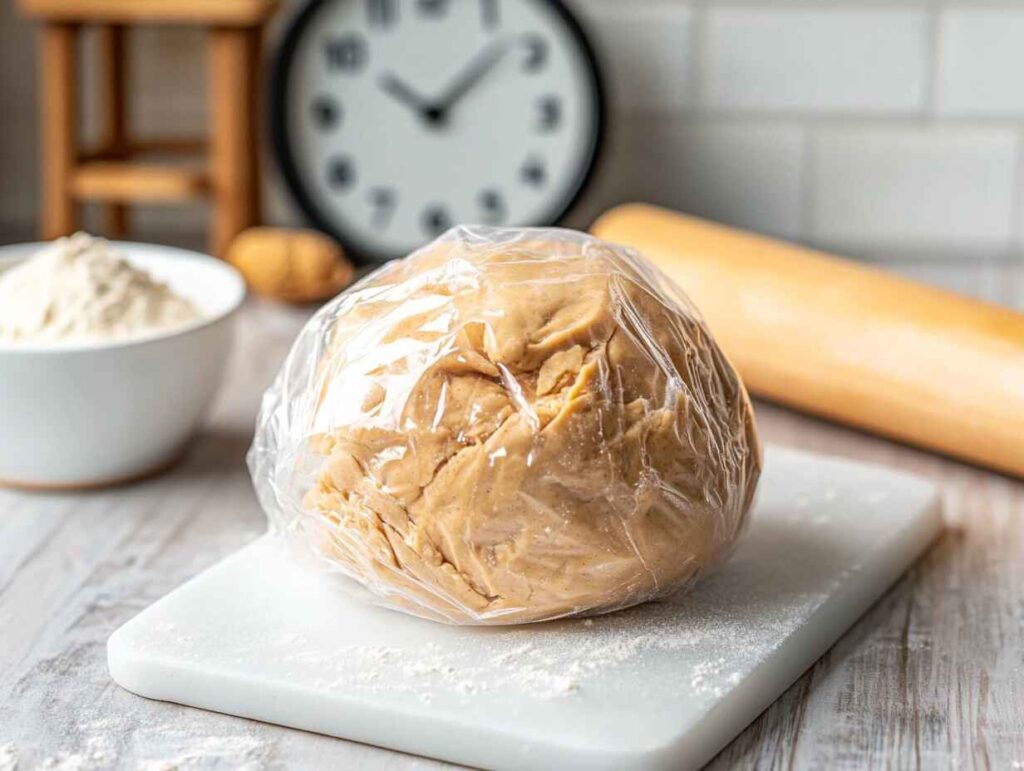
One trick that’s often overlooked is chilling the cookie dough before baking. Chilling the dough allows the fat to solidify, which helps prevent cookies from spreading too much during baking. The dough also absorbs moisture as it sits, which helps improve the texture and chewiness of the cookies. Chilled dough will hold its shape better and create thicker, chewier cookies.
Solution: After mixing your dough, wrap it in plastic wrap and chill it in the fridge for at least 30 minutes. If you have time, chilling the dough overnight can make a big difference. This extra step will give you firmer dough that bakes into perfect chewy cookies.
Using Baking Soda vs. Baking Powder for a Chewier Cookie
The type of leavening agent you use baking soda or baking powder can also impact the texture of your cookies. Baking soda is often preferred for chewy cookies because it promotes spread and tenderness. It also reacts with the acidic ingredients (like brown sugar or peanut butter) to create bubbles that give your cookies a soft, chewy center.
Solution: Stick with baking soda for your peanut butter cookies to get that signature chewiness. Be sure to measure it carefully; too much baking soda can give your cookies a metallic aftertaste!
Understanding the difference between these two leavening agents is key. Why do peanut butter cookies get hard dives deeper into this.
The Importance of Not Overmixing the Dough
We’ve touched on the importance of not overmixing the dough before, but it’s worth emphasizing. When you overmix your cookie dough, you activate the gluten in the flour too much, leading to cookies that are tough and not as chewy. This happens because the flour has been overworked, which creates a denser texture.
Solution: Mix your ingredients just until combined. You don’t need to knead or beat the dough just fold the ingredients together. The less mixing, the better for chewy cookies!
Troubleshooting Other Peanut Butter Cookie Issues
Sometimes, peanut butter cookies can still have issues, even if you’ve followed all the right steps. Let’s look at a couple of other common problems you might encounter when baking peanut butter cookies and how to solve them.
Why Are My Peanut Butter Cookies Flat?
Flat peanut butter cookies are often the result of dough that’s too warm or too soft before baking. If your dough isn’t chilled long enough or if you’ve used too much butter or peanut butter, the cookies can spread too much and become flat during baking.
Solution: Chill your dough for at least 30 minutes before baking. If your cookies still spread too much, check your ingredient ratios and make sure you’re not using too much butter or peanut butter.
Why Do My Peanut Butter Cookies Spread Too Much?
Cookies spreading too much can be frustrating, but it’s usually an easy fix. It often happens if the dough is too soft or the oven temperature is too low. When the dough is too warm, it spreads too quickly in the oven, resulting in thin, crispy cookies.
Solution: Chill the dough for 30 minutes to an hour before baking, and make sure your oven is preheated to the right temperature (350°F/175°C). If your cookies still spread too much, you can try adding a bit more flour to the dough to give it more structure.
Frequently Asked Questions (FAQs)
Should I use natural or regular peanut butter for chewy cookies?
Regular creamy peanut butter is the best choice for baking chewy peanut butter cookies. Natural peanut butter tends to separate, making the dough too oily or dry, which affects the texture.
Why do my peanut butter cookies turn out dry and crumbly?
Your cookies may be dry and crumbly due to too much flour, not enough fat or moisture, or overbaking. Measure flour carefully using the spoon-and-level method, and consider adding an extra egg yolk or a tablespoon of milk for added softness.
What’s the best way to prevent peanut butter cookies from spreading too much?
To prevent cookies from spreading too much, chill the dough for at least 30 minutes before baking. Also, make sure your oven is preheated to the right temperature (350°F/175°C), and avoid using too much butter or sugar, as these ingredients encourage spreading.
Conclusion: Baking the Perfect Peanut Butter Cookies Every Time
Why aren’t my peanut butter cookies chewy?” Achieving the perfect chewy peanut butter cookie is all about understanding the ingredients, the science of baking, and how to troubleshoot issues as they arise. With the tips and tricks we’ve shared, you’ll be able to bake cookies that are soft, chewy, and full of delicious peanut butter flavor every time. From choosing the right ingredients to adjusting your baking time, there are plenty of ways to perfect your recipe and impress your friends and family with your baking skills.
So, what are you waiting for? Grab your ingredients, get baking, and enjoy the chewy, nutty goodness of homemade peanut butter cookies! 🍪
If you’re still struggling, try one of our simple recipes like these 4-ingredient peanut butter cookies to get started.
Print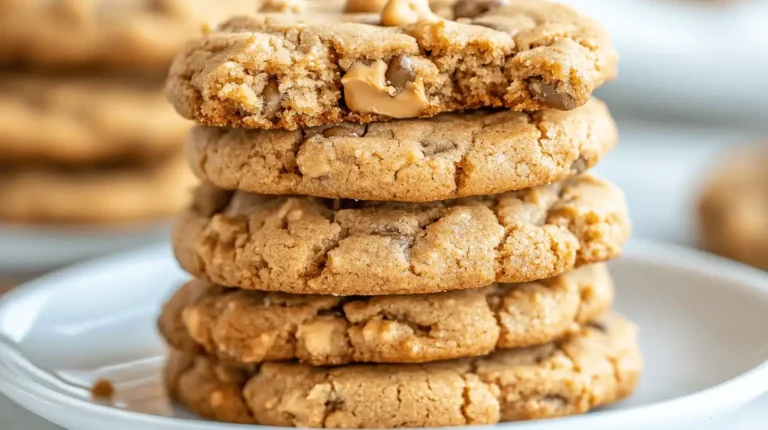
Why aren’t my peanut butter cookies chewy ?
These Chewy Peanut Butter Cookies are soft, tender, and packed with rich peanut butter flavor. With a slightly crisp edge and a melt-in-your-mouth texture, these cookies are perfect for any peanut butter lover. Easy to make, these cookies are the ultimate treat to satisfy your sweet cravings.
- Total Time: 18-20 minutes
- Yield: 20-24 cookies
Ingredients
1 cup peanut butter (smooth or chunky),
1 cup granulated sugar,
1 large egg,
1 teaspoon vanilla extract,
1/2 teaspoon baking soda,
1/4 teaspoon salt (optional, if peanut butter is unsalted),
1/2 cup all-purpose flour (optional for extra chewiness).
Instructions
- Preheat your oven to 350°F (175°C). Line a baking sheet with parchment paper.
- In a medium-sized bowl, combine peanut butter and sugar. Mix well until smooth and creamy.
- Add the egg and vanilla extract to the mixture and stir until fully combined.
- Mix in baking soda, salt, and flour (if using). Stir until the dough is smooth.
- Scoop tablespoon-sized portions of dough and roll them into balls. Place them on the prepared baking sheet, spacing them about 2 inches apart.
- Flatten each dough ball slightly with the back of a fork, creating a criss-cross pattern.
- Bake for 8-10 minutes or until the edges are golden brown. Keep an eye on them to avoid over-baking.
- Let the cookies cool on the baking sheet for 5 minutes before transferring them to a wire rack to cool completely.
Notes
For extra flavor, you can add chocolate chips or chopped peanuts into the dough before baking.
If the dough feels too sticky to handle, chill it in the fridge for 10-15 minutes before rolling into balls.
- Prep Time: 10 minutes
- Cook Time: 8-10 minutes
- Category: Dessert
- Method: Baking
- Cuisine: American
- Diet: Vegetarian

